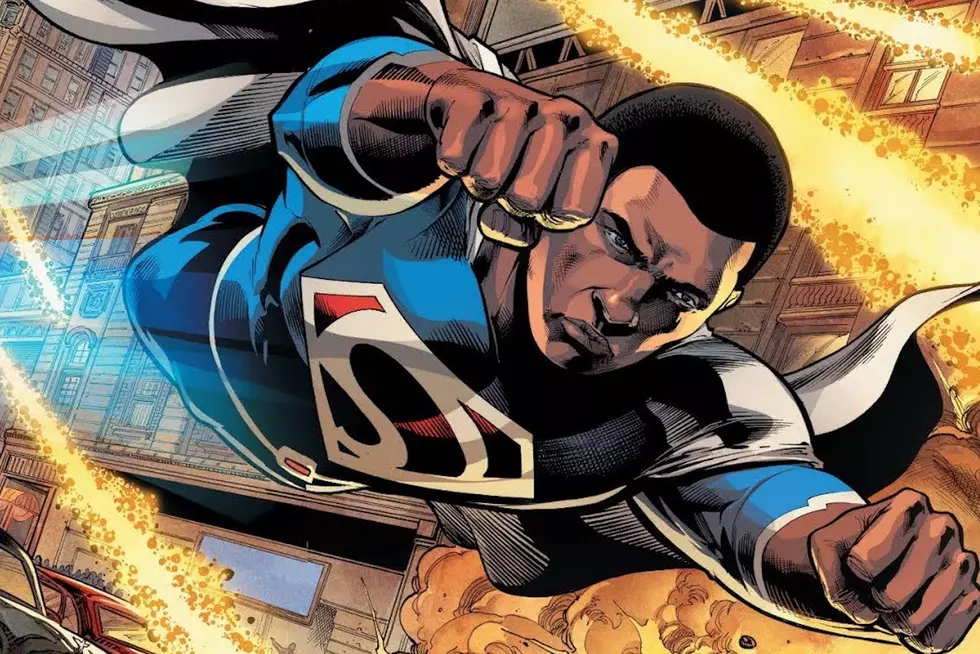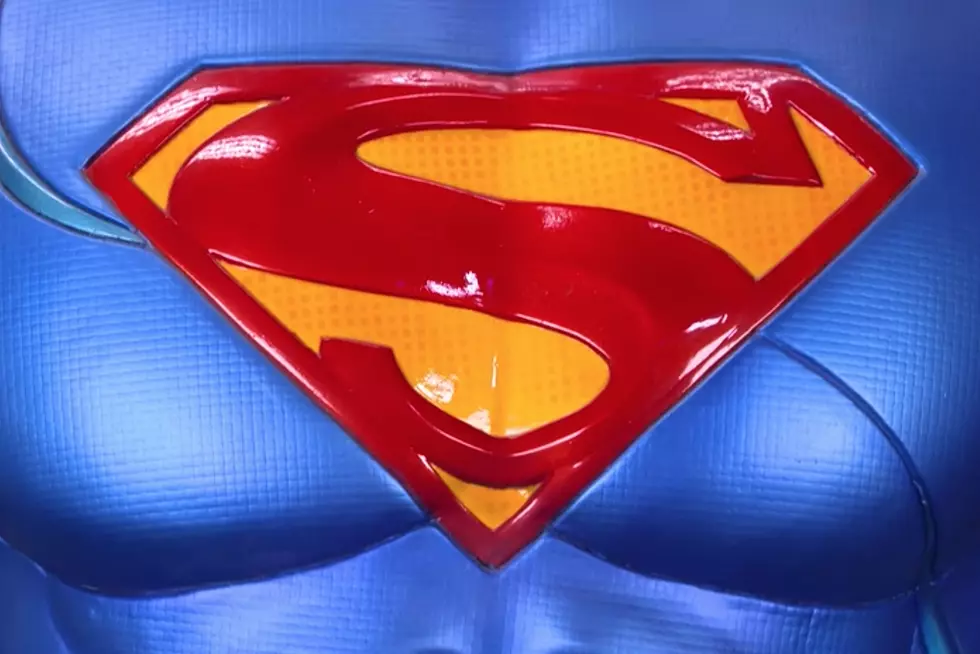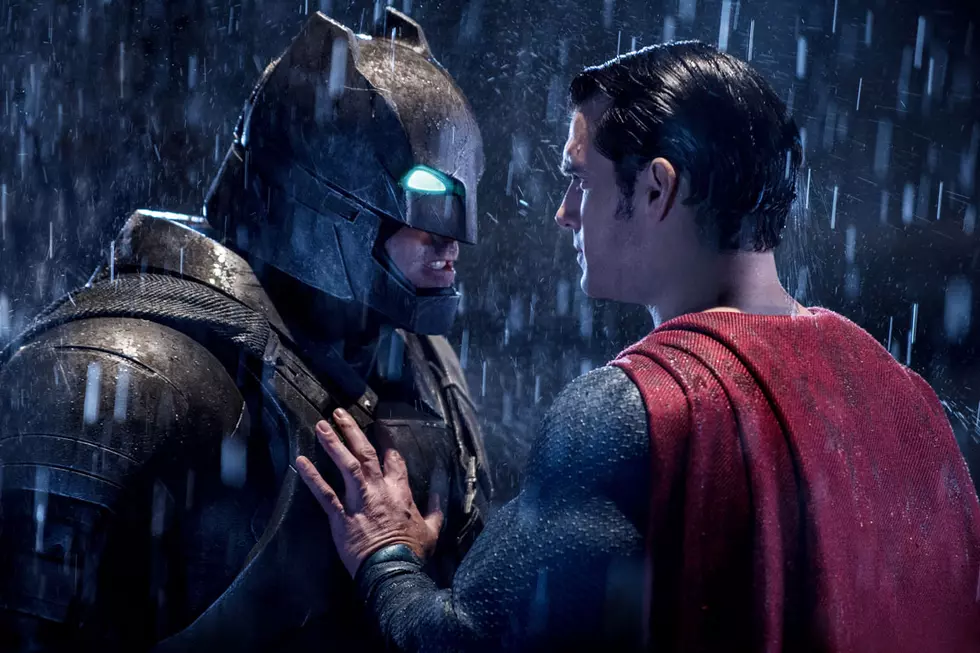
Electric Bluegaloo, Act 7: World Gone Wild
Of all the strange transformations Superman has undergone in his 78-year history, none has been quite so derided as the year where his familiar costume and powers were replaced with a blue and white "containment suit" and a tenuous relationship with electricity. But that raises the question, was it really all that bad? Two decades later, we want to find out, so ComicsAlliance is taking a look back at the Electric Blue Era of Superman to find out not just what worked, but if anything worked. This is... Electric Bluegaloo.
This week, the Electric Blue Era goes full Kirby, and Scorn has a date to the dance.
November, 1997:
- Superman: The Man of Steel #73, by Louise Simonson, Mark Waid, Scott Eaton, and Dennis Janke
- Superman #129, by Dan Jurgens, Paul Ryan, and Joe Rubenstein
- The Adventures of Superman #552, by Karl Kesel, Tom Grummett, and Denis Rodier
- Action Comics #739, by Stuart Immonen and Jose Marzan Jr.
It might seem weird to be talking about this right after we got through a month's worth of stories that featured the New Gods and the Source Wall, but there was a good chunk of the '90s where mainstream superhero comics seemed like they were trying to move as far away from Jack Kirby as they could. It's especially evident in the early '90s, when everyone seemed like they were ditching anything that might've been considered old-fashioned in an effort to move into the next big thing --- and since, y'know, most of those older concepts had been created or defined by Kirby in the first place, his influence fell by the wayside.
But even through all that, one of the few places where Kirby's influence stayed strong was on the Superman titles. Even when it wasn't at the forefront, all of those concepts that Kirby introduced in the Fourth World Saga --- including, of course, his run on Superman's Pal Jimmy Olsen --- were always there in some form. There's Darkseid, of course, but also Cadmus and the cloning project, the Guardian and the Newsboy Legion, Jimmy Olsen as "Mr. Action," Dabney Donovan's mad science, and Intergang. All of those elements had been weaved in tightly with how Superman was rebuilt for the '90s.
By the end of the decade, thanks largely to creators like Walt Simonson on Orion, Grant Morrison and Howard Porter on JLA, and even John Byrne on Jack Kirby's Fourth World, Kirby's style and influence had come back into vogue, but the Superman titles of the decade had kept it going for a while. And in October of 1997, they did it by going full-on Kirby.
In what might be the Kirbiest possible thing to see in a comic that doesn't actually involve the King, our story picks up with Jimmy Olsen being chased into the Wild Area outside metropolis by Intergang, only to find himself face-to-face with the Outsiders, the same super-weirdies on motorcycles who showed up way back in Kirby's first issue of SPJO in 1971. And that's just the tip of the Kirby iceberg.
As Jimmy discovers that the Outsiders are quite possibly the only people in the world who don't want him dead, Morgan Edge is plotting his takeover of Metropolis by appealing directly to Apokolips. He wants to oust Boss Moxie from control of Intergang, and after he assures Desaad that he plans on destroying the city rather than ruling it, Darkseid's chief torturer agrees to loan him a single batallion of Parademons until sundown to see what he can do with it.
And what he does is attack the Wild Area.
He doesn't just go after the Hairies, though, he also targets Lex Luthor, apparently with an intent to wipe out his only competition for control of the Metropolitan underworld. And honestly, as much as I appreciate the fast pace of the story, this is a story that I wish had gone on for a lot longer than a single issue.
I've written before about the strange, episodic pacing of the Superman books of the era, and one of the weird functions of it is how different plots will cycle through to prominence for a single issue before being relegated back to the background while other stuff steps up. On the one hand, it makes for a rapid-fire pace that tends to keep Superman in action, and genuinely makes it feel like there's an entire world around him that's in danger from all sides. But on the other hand, the storylines that the creators chose to emphasize aren't always the most interesting ones, at least to me.
Or, to put it another way, we got like three straight issues of Superman fighting Cyborg Superman during Genesis that were basically readable NyQuil, but a storyline with Intergang, the Outsiders, the Hairies, Superman and Lex Luthor having to team up to battle an army of Parademons, and the Mountain of Judgment?
If you don't know the Mountain of Judgment --- and you should --- it is neither a mountain nor particularly judgmental, and is instead a massive super-car designed to travel on the Zoomway while terrifying anyone who sees it with its gigantic draconian features. It's great and I love it.
But like I was saying, we only get that for 22 pages before it's time to clear the decks for something else. Even with the promise that we'll pick up on the idea of Jimmy Olsen invading Apokolips in a future issue, it's a little disappointing --- it's almost 20 years later and there's still nothing I want to read more than that.
Instead, we get even more Cyborg Superman. So good news for whoever wanted that, I guess.
To be fair, though, that piece of the story is more focused on the burgeoning relationship between Ashbury Armstrong --- the blind daughter of the Daily Planet's conservative columnist --- and Ceritak, the monstrous, horned alien from Kandor better known as Scorn. They've been going out for a while, and now, with Ashbury's homecoming dance on the horizon, they're about to have their biggest date ever.
And yes: It took me until this story, where we see Ashbury making some sculptures in art class, to realize that they were riffing on Ben Grimm and Alicia Masters.
Unfortunately for their young romance, Homecoming hits a major speed bump when it turns out that the new art teacher, Mr. Sormon, is actually Cyborg Superman --- a fact that's revealed when he gets so mad that his students have to make something for Superman Appreciation Day that he ends up sculpting a statue of himself so furiously fast that it burns the fake skin off of his robot hands. That's a plot point that would've been amazing in 1961, but in 1997, it is bananas, and I kind of love it.
Needless to say, Superman ends up taking him down...
... although he apparently survives by transferring his consciousness into the statue.
Because of the damage to the school, the Homecoming Dance ends up having to be moved to a different location: the ballroom of a high-rise hotel that's managed by one of Ashbury's classmates. At first, it seems like an upgrade, but, well. Superhero comics. You know how it goes.
This time, though, Ashbury (and Scorn) aren't the target. The whole thing is actually just a distraction meant to lure Superman into a deathtrap built by, well, Deathtrap.
If you're not familiar with him, he's the post-Crisis incarnation of Carl Draper, a Silver Age villain called the Master Jailer. By the time he shows up here, though, he's changed his name to Locksmith, and concocted a devious device meant to keep Superman trapped in a feedback loop that prevents him from expending energy. Unfortunately for him, it doesn't stop Superman from absorbing energy, and once Big Blue has drained Locksmith's machines of their power, it's a pretty simple matter for him to break out.
He gets away, though --- in a dynamic that you almost never see in superhero comics, it turns out that Locksmith is actually Carl's daughter Karla, who's been secretly running the whole scheme remotely from her computer. And considering it was her idea to get her dad to try trapping Superman to begin with, it makes for a pretty interesting setup.
Meanwhile, Lex Luthor has decided that it's time to deal with Intergang personally.
After Boss Moxie sends his crew of cloned super-gangsters --- Torcher, Noose, "Machine" Gunn and Roughhouse --- to steal some equipment from LexCorp, he ends up with a hostage in the form of Mensa, a genetic scientist on Lex's payroll. He offers her up for an exchange, but when Luthor shows up, the two crooks end up in a fistfight that finds Lex beating the living hell out of Moxie and asserting his dominance over Intergang.
It's pretty great, too. After seeing him in the background for so long while his trial played out, getting the return of the utterly ruthless, physically imposing, monumentally cruel Luthor is pretty good --- especially with the battle lines re-drawn between Luthor, Intergang, and Morgan Edge.
What Changed:
- Superman's new powers continued to be unreliable, leading to a fight with Doc Parasite that saw Superman draining him to a husk. Also, they remained pretty textually inconsistent, too, as Superman is now able to do everything from magnetizing guns to somehow rebuilding a burning skyscraper.
- Lex Luthor has unofficially taken control of Intergang from Boss Moxie.
- Jimmy Olsen has been recruited to invade Apokolips with the Hairies of the Wild Area.
- Lois Lane was dispatched to cover a story in Australia, where Aboriginal tribes have prophesied the coming of the world-ending Millennium Giants, foreshadowing the one big '90s Superman story that might actually be even less remembered than Genesis.
More From ComicsAlliance









